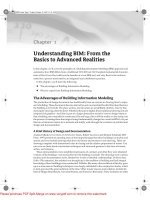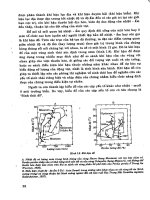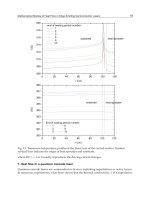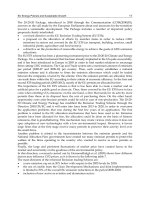Electronic Circuits - Part 2 ppt
Bạn đang xem bản rút gọn của tài liệu. Xem và tải ngay bản đầy đủ của tài liệu tại đây (1.34 MB, 82 trang )
Teacher: Dr. LUU THE VINH
&
The chapter outline is shown below.
The chapter outline is shown below.
Basic Stages
Emitter Follower
Push−Pull Stage
and Improved
Variants
Basic Stages
Emitter Follower
Push−Pull Stage
and Improved
Variants
Large-Signal
Considerations
Omission of
PNP Transistor
High-Fidelity
Design
Large-Signal
Considerations
Omission of
PNP Transistor
High-Fidelity
Design
Heat
Dissipation
Power Ratings
Thermal Runaway
Heat
Dissipation
Power Ratings
Thermal Runaway
Efficiency and
PA Classes
Efficiency of PAs
Classes of PAs
Efficiency and
PA Classes
Efficiency of PAs
Classes of PAs
PA - Power Amplifier
13.1 General Considerations
•
The reader may wonder why the amplifier stages studied in
previous chapters are not suited to high-power applications.
Suppose we wish to deliver 1 W to an 8Ω- speaker.
Approximating the signal with a sinusoid of peak amplitude
V
P
, we express the power absorbed by the speaker as:
•
The reader may wonder why the amplifier stages studied in
previous chapters are not suited to high-power applications.
Suppose we wish to deliver 1 W to an 8Ω- speaker.
Approximating the signal with a sinusoid of peak amplitude
V
P
, we express the power absorbed by the speaker as:
Where V
P
= p2 denotes the root mean square (rms) value
of the sinusoid and R
L
represents the speaker impedance.
For R
L
= 8Ω and P
out
= 1 W,
Where V
P
= p2 denotes the root mean square (rms) value
of the sinusoid and R
L
represents the speaker impedance.
For R
L
= 8Ω and P
out
= 1 W,
Also, the peak current flowing through the speaker is given by
Also, the peak current flowing through the speaker is given by
V
P
= 4V
(13.1)
Important observations
1) The resistance that must be driven by the amplifier is
much lower than the typical values (hundreds to
thousands of ohms) seen in previous chapters.
2) The current levels involved in this example are much
greater than the typical currents (milliamperes)
encountered in previous circuits.
3) The voltage swings delivered by the amplifier can hardly
be viewed as “small” signals, requiring a good
understanding of the large-signal behavior of the circuit.
4) The power drawn from the supply voltage, at least 1W, is
much higher than our typical values.
5) A transistor carrying such high currents and sustaining
several volts (e.g., between collector and emitter)
dissipates a high power and, as a result, heats up. High-
power transistors must therefore handle high currents
and high temperature.
1) The resistance that must be driven by the amplifier is
much lower than the typical values (hundreds to
thousands of ohms) seen in previous chapters.
2) The current levels involved in this example are much
greater than the typical currents (milliamperes)
encountered in previous circuits.
3) The voltage swings delivered by the amplifier can hardly
be viewed as “small” signals, requiring a good
understanding of the large-signal behavior of the circuit.
4) The power drawn from the supply voltage, at least 1W, is
much higher than our typical values.
5) A transistor carrying such high currents and sustaining
several volts (e.g., between collector and emitter)
dissipates a high power and, as a result, heats up. High-
power transistors must therefore handle high currents
and high temperature.
12.1 General Considerations
•
Based on the above observations, we can predict the parameters of
interest in the design of power stages:
(1) “Distortion,” i.e., the nonlinearity resulting from large-signal operation. A
high-quality audio amplifier must achieve a very low distortion so as to
reproduce music with high fidelity. In previous chapters, we rarely dealt
with distortion.
(2) “Power efficiency” or simply “efficiency,” denoted by η and defined as:
•
Based on the above observations, we can predict the parameters of
interest in the design of power stages:
(1) “Distortion,” i.e., the nonlinearity resulting from large-signal operation. A
high-quality audio amplifier must achieve a very low distortion so as to
reproduce music with high fidelity. In previous chapters, we rarely dealt
with distortion.
(2) “Power efficiency” or simply “efficiency,” denoted by η and defined as:
For example, a cellphone power amplifier that consumes 3 W from the
battery to deliver 1 W to the antenna provides η≈33,3%. In previous
chapters, the efficiency of circuits was of little concern because the
absolute value of the power consumption was quite small (a few
milliwatts).
For example, a cellphone power amplifier that consumes 3 W from the
battery to deliver 1 W to the antenna provides η≈33,3%. In previous
chapters, the efficiency of circuits was of little concern because the
absolute value of the power consumption was quite small (a few
milliwatts).
(3) “Voltage rating.” As suggested by Eq. (13.1), higher power levels or
load resistance values translate to large voltage swings and (possibly)
high supply voltages. Also, the transistors in the output stage must
exhibit breakdown voltages well above the output voltage swings.
(3) “Voltage rating.” As suggested by Eq. (13.1), higher power levels or
load resistance values translate to large voltage swings and (possibly)
high supply voltages. Also, the transistors in the output stage must
exhibit breakdown voltages well above the output voltage swings.
13.2 Emitter Follower as Power Amplifier
With its relatively low output impedance, the emitter follower may be
considered a good candidate for driving “heavy” loads, i.e., low
impedances. As shown in Chapter 5, the small-signal gain of the
follower is given by
With its relatively low output impedance, the emitter follower may be
considered a good candidate for driving “heavy” loads, i.e., low
impedances. As shown in Chapter 5, the small-signal gain of the
follower is given by
We may therefore surmise that for, say, R
L
=8Ω, a
gain near unity can be obtained if 1/gm<< R
L,
e.g.,
1/g
m
=0,8Ω , requiring a collector bias current of
32.5 mA. We assume β>>1.
We may therefore surmise that for, say, R
L
=8Ω, a
gain near unity can be obtained if 1/gm<< R
L,
e.g.,
1/g
m
=0,8Ω , requiring a collector bias current of
32.5 mA. We assume β>>1.
But, let us analyze the circuit’s behavior in delivering large voltage
swings (e.g. 4 V
P
) to heavy loads. To this end, consider the follower
shown in Fig. 13.1(a), where I1 serves as the bias current source. To
simplify the analysis, we assume the circuit operates from negative
and positive power supplies, allowing V
out
to be centered around zero.
For V
in
≈ 0,8 V, we have V
out
≈ 0 and I
C
≈32,5 mA. If V
in
rises from 0.8
V to 4.8 V, the emitter voltage follows the base voltage with a relatively
constant difference of 0.8 V, producing a 4-V swing at the output [Fig.
13.1(b)].
But, let us analyze the circuit’s behavior in delivering large voltage
swings (e.g. 4 V
P
) to heavy loads. To this end, consider the follower
shown in Fig. 13.1(a), where I1 serves as the bias current source. To
simplify the analysis, we assume the circuit operates from negative
and positive power supplies, allowing V
out
to be centered around zero.
For V
in
≈ 0,8 V, we have V
out
≈ 0 and I
C
≈32,5 mA. If V
in
rises from 0.8
V to 4.8 V, the emitter voltage follows the base voltage with a relatively
constant difference of 0.8 V, producing a 4-V swing at the output [Fig.
13.1(b)].
•
Now suppose V
in
begins from +0,8 V and gradually goes down [Fig.
13.1(c)]. We expect
V
out
to go below zero and hence part of I1 to flow from R
L
. For
example, if V
in
≈ 0,7 V, t h e n V
out
≈ 0,1 V, and R
L
carries a current of
12.5 mA. That is, I
C1
≈ I
E1
=20 mA. Similarly, if Vin ≈ 0,6 V, t h e n Vout
≈ 0,2 V, I
RL
≈ 25 mA, and hence I
C1
≈ 7,5 mA. In other words, the
collector current of continues to fall.
•
Now suppose V
in
begins from +0,8 V and gradually goes down [Fig.
13.1(c)]. We expect
V
out
to go below zero and hence part of I1 to flow from R
L
. For
example, if V
in
≈ 0,7 V, t h e n V
out
≈ 0,1 V, and R
L
carries a current of
12.5 mA. That is, I
C1
≈ I
E1
=20 mA. Similarly, if Vin ≈ 0,6 V, t h e n Vout
≈ 0,2 V, I
RL
≈ 25 mA, and hence I
C1
≈ 7,5 mA. In other words, the
collector current of continues to fall.
13.2 Emitter Follower as Power Amplifier
What happens as Vin becomes more negative? Does V
out
still track V
in
? We
observe that for
a sufficiently low V
in
, the collector current of Q1 drops to zero and R
L
carries
the entire I
1
[Fig.
13.1(d)]. For lower values of V
in
,Q
1
remains off and V
out
= - I
1
R
L
= -260mV.
Since, Eqs. (13.5) and (13.6) can be
combined to yield
(13.5)
(13.6)
Beginning with a guess V
out
= -0,2V and after a few iterations, we
obtain
Note from (13.6) that I
C1
≈
6,13 mA. To determine the value of V
in
that
yields I
C1
≈ 0,01I1 =0,325 mA, we eliminate V
out
from Eqs. (13.5) and
(13.6):
Note from (13.6) that I
C1
≈
6,13 mA. To determine the value of V
in
that
yields I
C1
≈ 0,01I1 =0,325 mA, we eliminate V
out
from Eqs. (13.5) and
(13.6):
Setting I
C1+
= 0,325mA, we obtain
Note from (13.5) that V
out
≈257mV under this condition.
Note from (13.5) that V
out
≈257mV under this condition.
Let us summarize our thoughts thus far. In the arrangement
of Fig. 13.1(a), the output tracks he input 2 as V
in
rises
because Q1 can carry both I1 and the current drawn by R
L
.
On the other hand, as V
in
falls, so does I
C1
, eventually
turning Q1 off and leading to a constant output voltage even
though the input changes. As illustrated in the waveforms of
Fig. 13.2(a), the output is severely distorted. From another
perspective, the input/output characteristic of the circuit,
depicted in Fig. 13.2(b), begins to substantially depart from a
straight line as Vin falls below approximately 0.4 V (from
Example 13.1)
•
Our foregoing study reveals that the follower of Fig. 13.1(a) cannot
deliver voltage swings
as large as U4 V to an 8- speaker. How can we remedy the situation?
Noting that V
out
; min =
I
1
R
L
, we can increase I1 to greater than 50 mA so that for V
out
= 4
V,Q1 still remains on.
This solution, however, yields a higher power dissipation and a lower
efficiency.
•
Our foregoing study reveals that the follower of Fig. 13.1(a) cannot
deliver voltage swings
as large as U4 V to an 8- speaker. How can we remedy the situation?
Noting that V
out
; min =
I
1
R
L
, we can increase I1 to greater than 50 mA so that for V
out
= 4
V,Q1 still remains on.
This solution, however, yields a higher power dissipation and a lower
efficiency.
Considering the operation of the emitter follower in the previous
section, we postulate that the performance can be improved if I1
increases only when needed. In other words, we envision an
arrangement where in I1 increases as V
in
becomes more negative and
vice versa. Shown in Fig.13.3(a) is a possible realization of this idea.
Here, the constant current source is replaced with a emitter follower so
that, as begins to turn off, “kicks in” and allows to track .
Considering the operation of the emitter follower in the previous
section, we postulate that the performance can be improved if I1
increases only when needed. In other words, we envision an
arrangement where in I1 increases as V
in
becomes more negative and
vice versa. Shown in Fig.13.3(a) is a possible realization of this idea.
Here, the constant current source is replaced with a emitter follower so
that, as begins to turn off, “kicks in” and allows to track .
13.3 Push-Pull Stage
13.3 Push-Pull Stage
Called the “push-pull” stage, this circuit merits a detailed study. We
note that if V
in
is sufficiently positive, Q1 operates as an emitter
follower, V
out
= V
in
- V
BE1
, and Q2 remains off [Fig.13.3(b)] because its
base-emitter junction is reverse-biased. By symmetry, if V
in
is
sufficiently
negative, the reverse occurs [Fig. 13.3(c)] and V
out
= V
in
+ [V
BE2
]. Wesay
Q1 “pushes” current
Into R
L
in the former case and Q2 “pulls” current from RL in the latter.
Called the “push-pull” stage, this circuit merits a detailed study. We
note that if V
in
is sufficiently positive, Q1 operates as an emitter
follower, V
out
= V
in
- V
BE1
, and Q2 remains off [Fig.13.3(b)] because its
base-emitter junction is reverse-biased. By symmetry, if V
in
is
sufficiently
negative, the reverse occurs [Fig. 13.3(c)] and V
out
= V
in
+ [V
BE2
]. Wesay
Q1 “pushes” current
Into R
L
in the former case and Q2 “pulls” current from RL in the latter.
Figure 13.4 Push-pull stage characteristic.
Figure 13.5 Push-pull stage characteristic with dead zone.
Figure 13.5 Push-pull stage characteristic with dead zone.
What happens as V
in
approaches zero? The rough
characteristic in Fig. 13.4
suggests that the two segments
cannot meet if they must remain
linear. In other words, the overall
characteristic inevitably incurs
nonlinearity and resembles that
shown in Fig. 13.5, exhibiting a
“dead zone” around .
What happens as V
in
approaches zero? The rough
characteristic in Fig. 13.4
suggests that the two segments
cannot meet if they must remain
linear. In other words, the overall
characteristic inevitably incurs
nonlinearity and resembles that
shown in Fig. 13.5, exhibiting a
“dead zone” around .
Why does the circuit suffer from a dead zone? We make two
observations:
•
First, Q1 and Q2 cannot be on simultaneously: for Q1 to be on,V
in
>V
out
,
but for Q2, V
in
<V
out
.
•
Second, if V
in
=0, V
out
must also be zero. This can be proved by
contradiction.
Why does the circuit suffer from a dead zone? We make two
observations:
•
First, Q1 and Q2 cannot be on simultaneously: for Q1 to be on,V
in
>V
out
,
but for Q2, V
in
<V
out
.
•
Second, if V
in
=0, V
out
must also be zero. This can be proved by
contradiction.
•
For example, if V
out
> 0 (Fig.
13.6), then the current must be
provided by (from V
CC
), requiring
V
BE1
>0 and hence V
out
= V
in
-V
BE1
< 0.
That is, for V
in
=0, both transistors
are off.
•
For example, if V
out
> 0 (Fig.
13.6), then the current must be
provided by (from V
CC
), requiring
V
BE1
>0 and hence V
out
= V
in
-V
BE1
< 0.
That is, for V
in
=0, both transistors
are off.
Now suppose V
in
begins to increase
from zero. Since V
out
is initially at zero,
V
in
must reach at east V
BE
≈ 600-700mV
before Q1 turns on. The output therefore
remains at zero for V
in
< 600mV,
exhibiting the dead zone depicted in Fig.
13.5. Similar observations apply to the
dead zone for V
in
<0.
Now suppose V
in
begins to increase
from zero. Since V
out
is initially at zero,
V
in
must reach at east V
BE
≈ 600-700mV
before Q1 turns on. The output therefore
remains at zero for V
in
< 600mV,
exhibiting the dead zone depicted in Fig.
13.5. Similar observations apply to the
dead zone for V
in
<0.
Figure 13.6 Push-pull stage with zero input voltage.
Figure 13.7 Gain of push-pull stage as a function of input.
Solution
•
For V
in
well above 600 mV, either Q1 or Q2 serves as an emitter follower,
thus producing a reasonable sinusoid at the output. Under this condition,
the plot in Fig. 13.5 indicates that V
out
= V
in
+ /V
BE2
/ or V
in
- V
BE1
. Within the
dead zone, however, V
out
≈ 0. Illustrated in Fig.13.8, V
out
exhibits distorted
“zero crossings.” We also say the circuit suffers from “crossover
distortion”`
Solution
•
For V
in
well above 600 mV, either Q1 or Q2 serves as an emitter follower,
thus producing a reasonable sinusoid at the output. Under this condition,
the plot in Fig. 13.5 indicates that V
out
= V
in
+ /V
BE2
/ or V
in
- V
BE1
. Within the
dead zone, however, V
out
≈ 0. Illustrated in Fig.13.8, V
out
exhibits distorted
“zero crossings.” We also say the circuit suffers from “crossover
distortion”`









